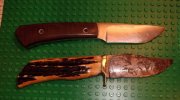I've been doing enough experiments with putting patinas on my carbon steel knives that I've made some conclusions which I'll share here. The best method for putting a dark patina on a carrbon steel knife is with a fruit of the Quince tree (see photo).
 Next, to this a green apple works well too. One that is old and half dried out seems to work the best. The Quince fruit is very acidic but is also very dry for a fruit. It seems that the combination of semi-dry yet acidic fruit tissue in contact with the steel in the presents of lots of oxygen create a very black color. I stick the knife in the fruit and leave it for 24 hours in a warm place. Where the fruit contacts the steel well (and gets oxygen) will turn black. In spots where there's too much juice, it seems to prevent oxygen from entering and does not change color. Trials with the juice of the same fruit left to dry on the blade did not produce the same results as when the semi-dry fruit is left in contact with the steel. Other experiments with vinegar, mustard, oranges and potatoes did not produce as dark a patina as with the semi-dry Quince or Apple fruits. Older semi-dried fruit works much better than fresh fruit, I believe a key to the dark staining reaction is the amount of oxygen that gets into the porous fruit while in contact with the blade. I discovered this last summer when a picked up a bunch of old apples in the yard. Due to our very dry climate they were half dried and shriveled. After a day's contact one could see that half-dried apple tissue had turned very black in contact with the steel and left a very black stain. This was particulary evident near the outer edges where oxygen and drying air were more plentiful. Where the steel was buried in juicier parts of the apple, there was no darkening. Attached is a photo of a 1095 blade and an A2 blade left on the Quince fruit for several days. Appearantly the A2 steel has enough chromium that no staining occurs (which is good in it's own way).
Next, to this a green apple works well too. One that is old and half dried out seems to work the best. The Quince fruit is very acidic but is also very dry for a fruit. It seems that the combination of semi-dry yet acidic fruit tissue in contact with the steel in the presents of lots of oxygen create a very black color. I stick the knife in the fruit and leave it for 24 hours in a warm place. Where the fruit contacts the steel well (and gets oxygen) will turn black. In spots where there's too much juice, it seems to prevent oxygen from entering and does not change color. Trials with the juice of the same fruit left to dry on the blade did not produce the same results as when the semi-dry fruit is left in contact with the steel. Other experiments with vinegar, mustard, oranges and potatoes did not produce as dark a patina as with the semi-dry Quince or Apple fruits. Older semi-dried fruit works much better than fresh fruit, I believe a key to the dark staining reaction is the amount of oxygen that gets into the porous fruit while in contact with the blade. I discovered this last summer when a picked up a bunch of old apples in the yard. Due to our very dry climate they were half dried and shriveled. After a day's contact one could see that half-dried apple tissue had turned very black in contact with the steel and left a very black stain. This was particulary evident near the outer edges where oxygen and drying air were more plentiful. Where the steel was buried in juicier parts of the apple, there was no darkening. Attached is a photo of a 1095 blade and an A2 blade left on the Quince fruit for several days. Appearantly the A2 steel has enough chromium that no staining occurs (which is good in it's own way).


